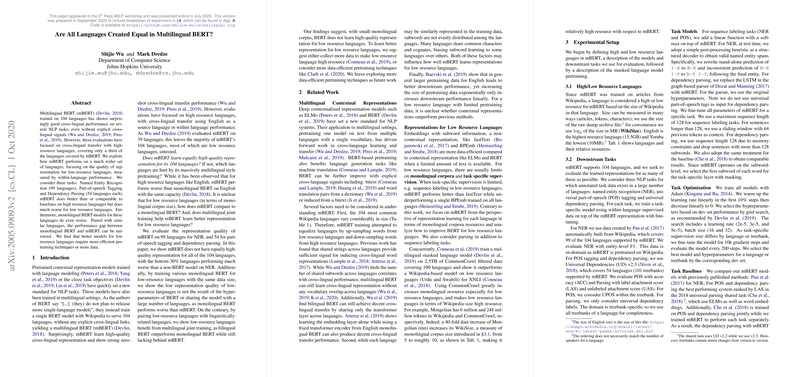Analysis of mBERT Representation Quality for Low-Resource Languages
The paper provides an in-depth evaluation of Multilingual BERT (mBERT), a pre-trained LLM trained on 104 languages, in terms of its ability to produce high-quality language representations, particularly for low-resource languages, focusing on Named Entity Recognition (NER), Part-of-Speech (POS) tagging, and Dependency Parsing. The paper's insights are derived from evaluating a wide range of languages, studying mBERT's ability to understand languages with varying resource availability, and contrasting it with monolingual and bilingual BERT models.
Main Findings
- Representation Quality in Low-Resource Languages:
- mBERT exhibits strong performance for high-resource languages but shows significantly lower performance for low-resource languages.
- Languages with Wikipedia size less than a certain threshold (WikiSize 6), representing about 30% of mBERT-supported languages, perform markedly worse in comparison to languages with more resources.
- There is a marked performance drop in both NER and other parsing tasks when the available labeled data for specific low-resource languages is minimal.
- Comparison with Baseline Models:
- Despite mBERT's impressive performance on high-resource languages, for the bottom 30% of languages, non-pre-trained baseline models surpass mBERT in performance.
- This discrepancy further underscores mBERT's limitations in handling low-resource languages effectively, despite the multilingual nature and its evident advantages in cross-lingual transfer tasks for resource-rich languages.
- Monolingual and Bilingual BERT Models:
- Monolingual BERT models trained on low-resource languages do not surpass mBERT in performance, suggesting that the issue lies in the overall data scarcity and the inefficiency of pretraining procedures rather than mBERT's multilingual setting.
- Bilingual BERT models, pairing low-resource languages with closely related higher resource languages, show improvement over monolingual BERT models. However, these models still do not match mBERT's performance.
Implications and Future Directions
The results imply that current pre-training approaches like those used in mBERT are not enough to provide quality LLMs for low-resource languages. This limitation is significant because any NLP application relying on these models—especially those intended for global reach—will inherently struggle to perform satisfactorily in less well-supported languages.
For practical implications, developers and researchers should be aware of limitations when deploying mBERT across various languages and ensure that low-resource languages are accounted for when possible with supplementary data collection and model adjustments.
The paper suggests that future advancements could focus on more data-efficient training techniques or the acquisition of broader and larger datasets for low-resource languages. The potential of more sophisticated approaches, such as those explored in the ELECTRA model and other emerging data-efficient techniques, could be explored further.
Future work may also investigate the potential of leveraging multilingual data to create curated datasets or adaptive training regimes that enhance low-resource representation. Research could explore smart sampling strategies or the integration of multilingual cues beyond simple cross-lingual vocabulary to better support a robust learning process in low-resource scenarios.
In summary, while mBERT presents a significant stride forward for multilingual language representation, the paper highlights critical areas where it falters. This paper provides valuable insights that could guide future work in making multilingual models more universally applicable, catering particularly to the needs of low-resource languages.
